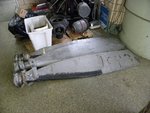The P51 had a fat, 4 blade, square tip prop, the Corsair Hellcat and Thunderbolt had a skinny toothpick looking prop even though they had much more horsepower. I know later on they put a paddle prop on the Thunderbolt, but not the Corsair or Hellcat.
Why didn't they put a fat square tipped prop on the Corsair, Hellcat and Thunderbolt? What about a 5 bladed prop on those 3 aircraft? Would a 5 bladed toothpick prop be as effective as a 4 bladed paddle?Would it have helped top speed or climb rate?
I would really like to hear a technical answer from some of you engineer guys. Thanks.
Why didn't they put a fat square tipped prop on the Corsair, Hellcat and Thunderbolt? What about a 5 bladed prop on those 3 aircraft? Would a 5 bladed toothpick prop be as effective as a 4 bladed paddle?Would it have helped top speed or climb rate?
I would really like to hear a technical answer from some of you engineer guys. Thanks.

